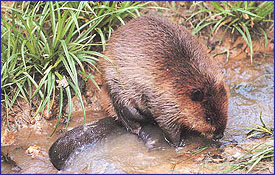ABOUT BEAVERS
The Beaver is a semiaquatic rodent noted for the building of dams. There are only two kinds of beavers, the American beaver and the Eurasian beaver. The two species share similar behavior and anatomy, although they have some physical differences, such as the shape of the nasal bones. They are large rodents; the average adult beaver weighs about 16 kg (about 35 lb) but specimens as heavy as 40 kg (90 lb) have been found, and some extinct beavers were almost bearlike in size.
©2016 Endeavor Ballooning - All Rights Reserved
Characteristics
The beaver is usually about 76 cm (about 30 in) long and stands less than 30 cm (12 in) high. The broad, flat, scaly tail is about 25 cm (about 10 in) long and serves as a warning signal when slapped against the water, as a support when the beaver is standing on its hind legs, and as a rudder while swimming. The body is plump, the back arched, the neck thick, the hind feet webbed, and all the digits clawed. The fur is usually reddish-brown above and lighter or grayish below. The eyes are small and the nostrils closable. The skull is massive, with marked ridges for fixing the muscles that work the jaws. The two front teeth on either jaw are like those of other rodents, wearing away more rapidly behind so as to leave a sharp, enameled chisel edge. With these the beaver can cut down large trees.
For more information on beavers, click here
It usually selects trees 5 to 20 cm (2 to 8 in) in diameter, but it can fell trees with diameters as large as 76 cm (30 in).Beavers have a pair of anal scent glands, called castors, that secrete musklike substance call castoreum, probably for marking territories. The animals tend to be monogamous and may live 20 years or more. The female has one litter a year, usually of two to four young.


